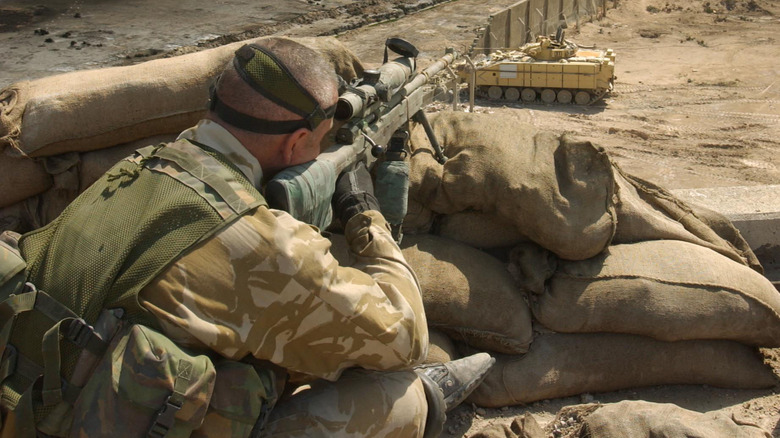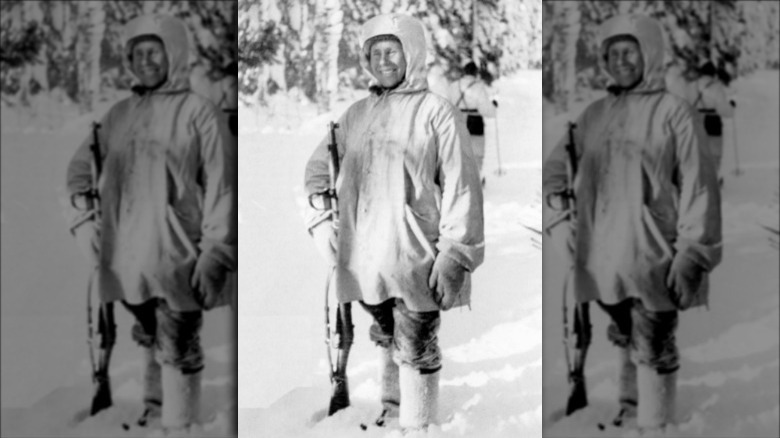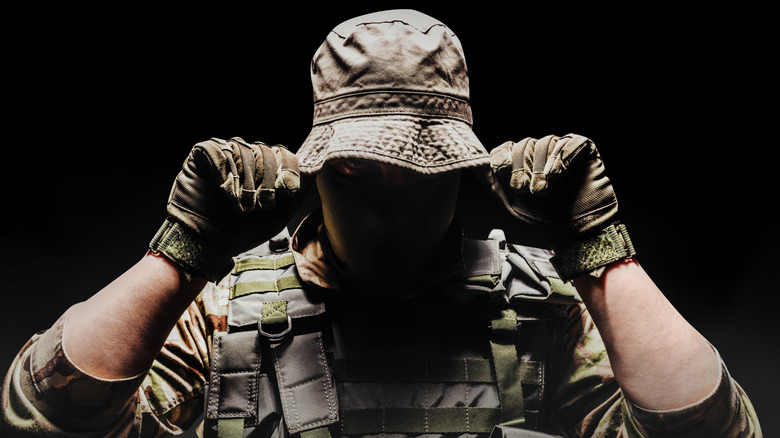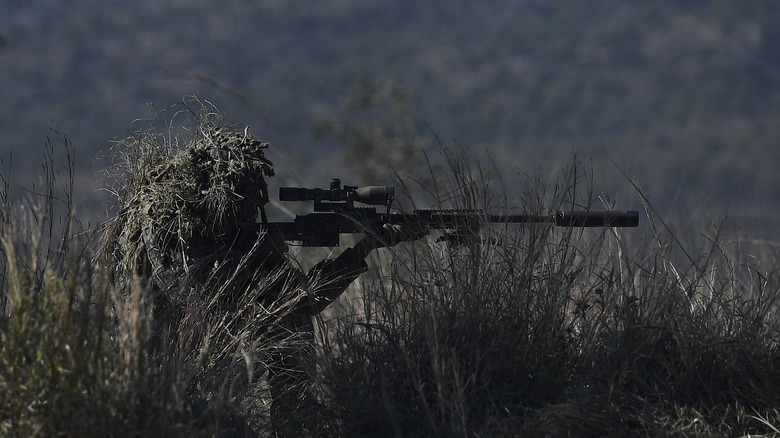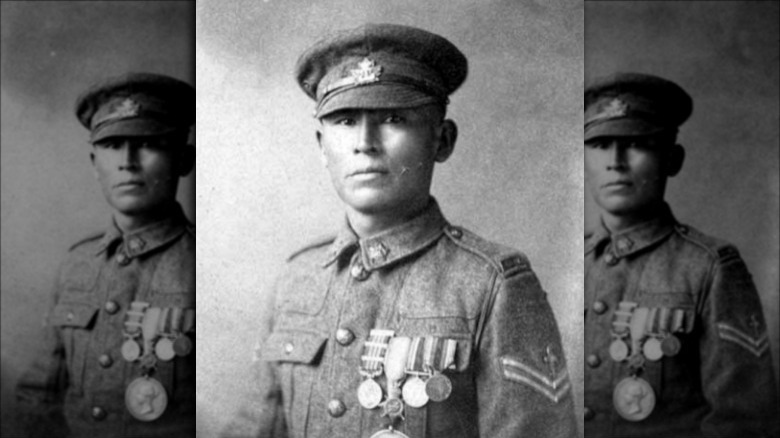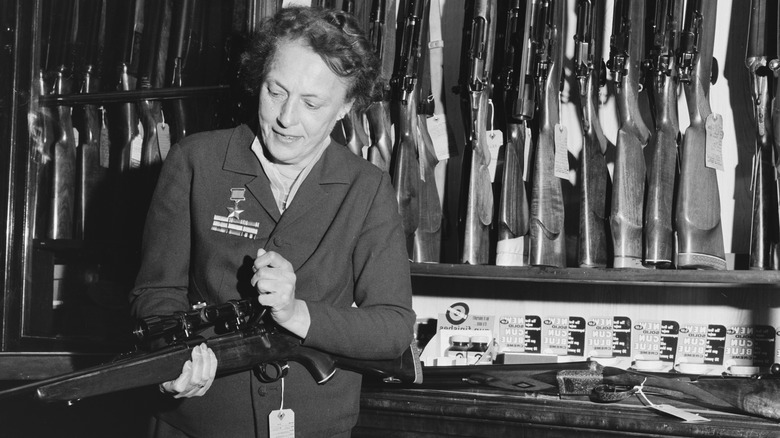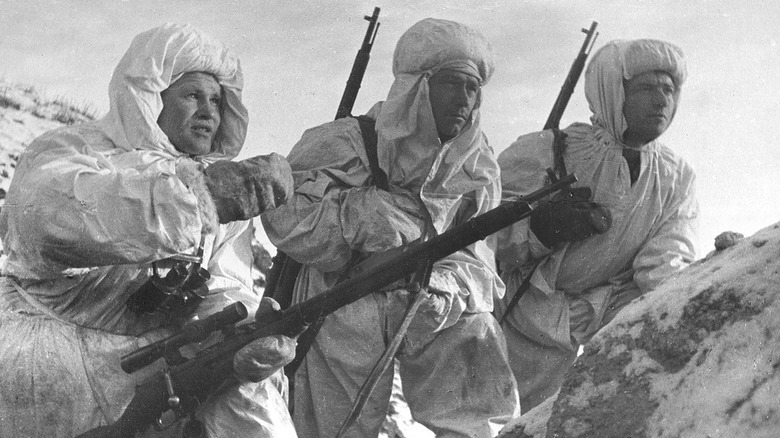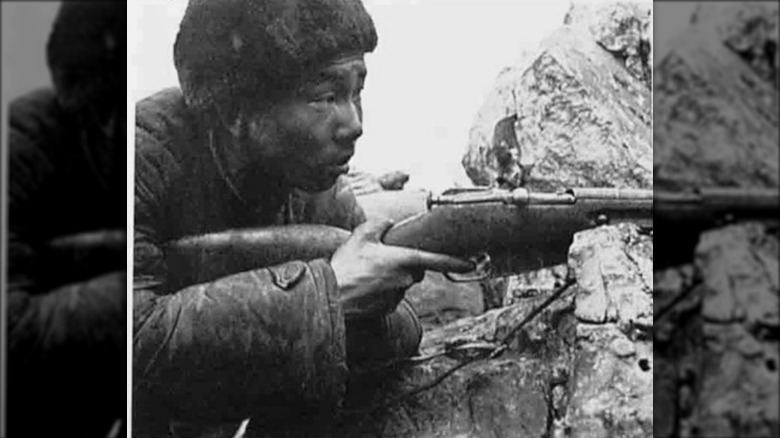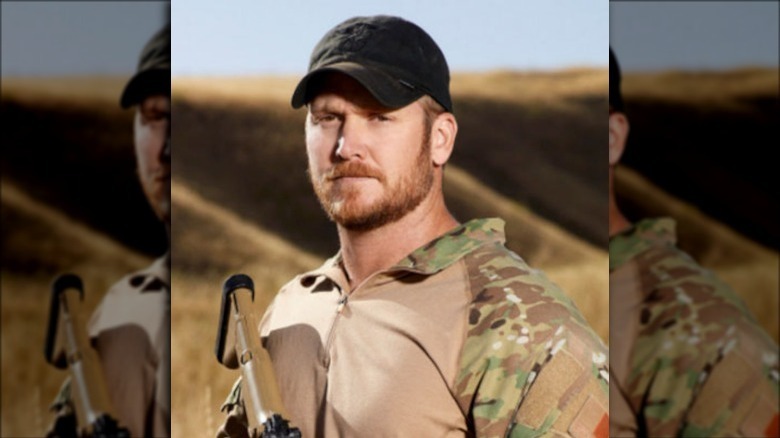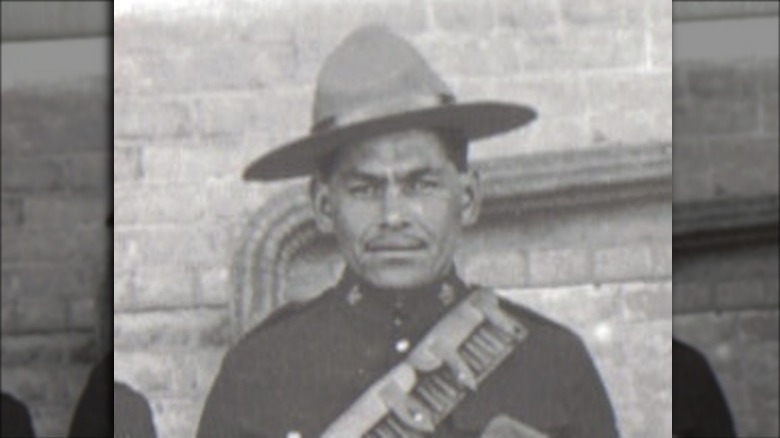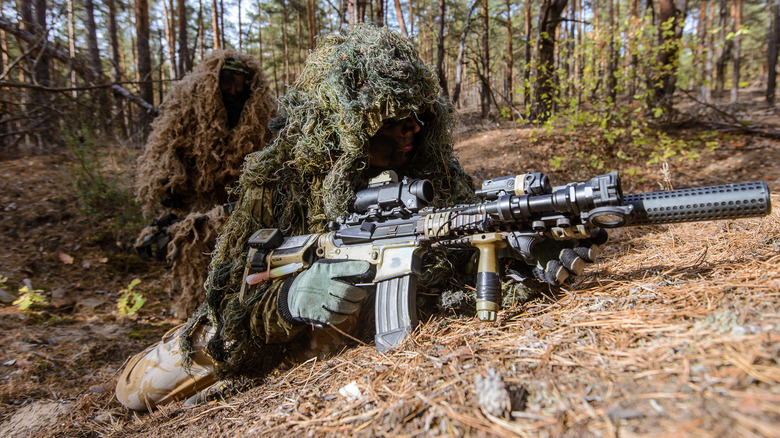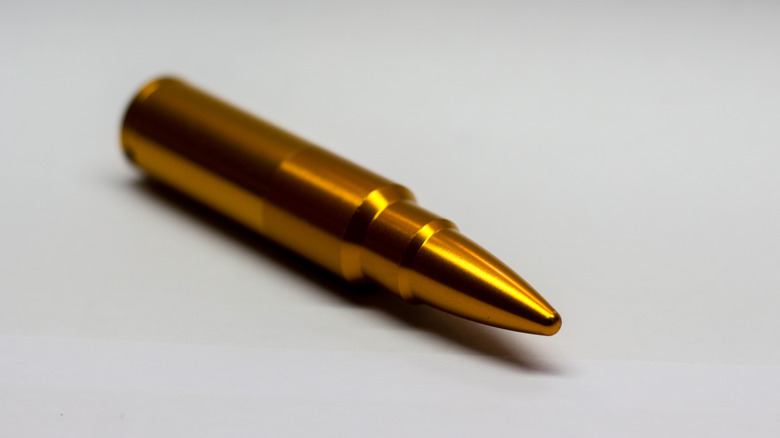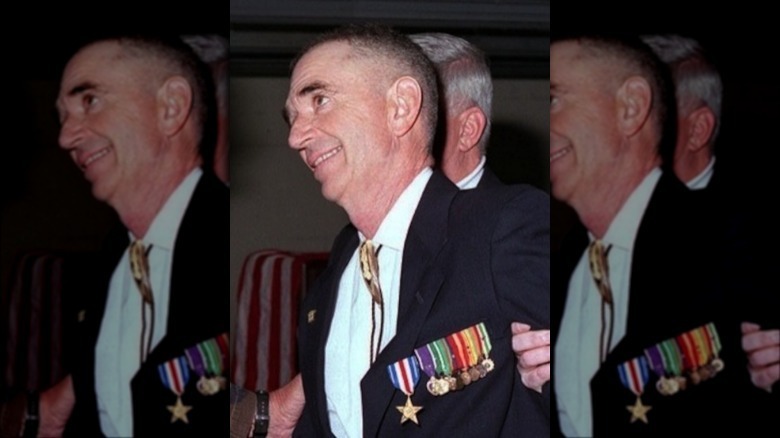Deadliest Snipers Throughout History
We find snipers fascinating because they're shrouded in mystery. Hidden, calm, and coolly professional, they bide their time and strike with deadly force. And the psychological impact of a successful sniper is arguably more important than the actual kills — death dealt from an invisible enemy in an unseen location has a powerful effect.
Being a sniper is incredibly difficult, of course — and dangerous. Aside from the level of skill and training required to become not just a great shot but an expert with your weapon, you also need the skills of a hunter and an expert tracker. You need to be able to identify the perfect hiding spots and create camouflage on the fly. And above all, you need incredible patience to wait for the perfect moment and conditions, often under the most stressful of circumstances.
The men and women on this list are people who have all of those qualities. From disparate backgrounds and cultures, they stepped forward to serve their country in times of war and used their skills to deal with death at a truly frightening rate. With dozens and even hundreds of kills to their credit, here are the deadliest snipers throughout history.
Simo Häyhä: 542 kills
Although we tend to think of World War II as a single, monolithic conflict, there were distinct wars separate from the global conflagration. The Winter War between the Soviet Union and Finland is one such battle, and although it only lasted 105 days between 1939 and 1940, it was long enough for a humble farmer named Simo Häyhä to become the deadliest sniper in modern history.
According to HistoryExtra, Häyhä was born in 1905 in a region of Finland that is today part of Russia. A farmer, he enjoyed hunting, skiing, and shooting, which just happen to be the precise skill set required to be a deadly sniper during the Winter War, as noted by Forces.net. His habit of hunting birds and foxes required him to learn how to hide, remain perfectly still, and wait for the perfect opportunity to strike. By all accounts, Häyhä was unemotional about his work, fearlessly working alone and once stating that he didn't hate the enemy — he simply did his job to the best of his ability.
Häyhä served just 98 days before an injury sent him to the hospital. In those 98 days, he killed an absolutely terrifying 542 Russians, at a time and location when there was very little sunlight to work with. This impressively deadly resume earned him the nickname "White Death."
Ivan Sidorenko: More than 500 kills
As reported by War History Online, Ivan Sidorenko was an unlikely sniper. Born into a poor family, he enrolled in an art school just before World War II. When he was drafted into the Soviet Army in 1939, he was assigned to a mortar unit and given exactly zero training as a sniper. He was issued the standard army weapon: the Mosin-Nagant rifle. Military Times explains that this rifle was modified by the Soviets to accommodate a scope, making it suitable as a sniper rifle. Although often regarded as too long and heavy, it was actually incredibly accurate — as Sidorenko soon proved.
According to Range365, Sidorenko was self-trained. In his downtime as part of the mortar unit, he took it upon himself to go out and hunt for German soldiers and is credited with over 500 kills. One reason he was able to rack up so many official kills was because he didn't just target individual soldiers — he also went after fuel supply vehicles using explosive rounds. Sidorenko's impact was even greater, though, as he began training other snipers, eventually sending some 250 snipers out into the war. Even if they were half as good as their teacher, that would make Sidorenko one of the most formidable enemies the Germans ever faced.
Fyodor Okhlopkov: 429 kills
Despite an epic number of confirmed kills, Fyodor Okhlopkov isn't well known even inside the former Soviet Union. And that's because of simple racism: As noted by History Collection, Okhlopkov was an ethnic Yakut from the eastern portion of Russia, in what is today the Republic of Sakha. In "Russia's Heroes," historian Albert Axell said the Yakuts are known for their self-reliance and were traditionally skilled at tracking and hunting; they were also known to be expert sharpshooters.
Okhlopkov took up sniping in a serious way after a German sniper killed his brother, Vasily. He vowed to "open an account" and start adding Germans to it — and didn't stop. He would reportedly hunt at night, looking for the coals of cigarettes and other small clues to point him to the enemy. As noted by War History Online, he would also employ automatic weapons, and his commanding officers often sent him with a machine gun to clear out German resistance. His overall kill total is estimated to have been north of 1,000, but most of those kills are not considered part of his official sniper tally of 429. Ohklopkov was finally awarded the honor of Hero of the Soviet Union in 1965 and received the Order of Lenin.
Francis Pegahmagabow: 378 kills
You don't normally think of Canadians as a bloodthirsty group, and guys named "Francis" don't have a reputation for being good at killing. But back in World War I, Francis Pegahmagabow put the lie to both those assumptions. As reported by Range365, Pegahmagabow was a member of the indigenous First Nations and volunteered to serve in the First World War in 1914. The Canadian Encyclopedia notes that Pagahmagabow — nicknamed "Peggy" by his friends — was raised in the traditions of the Anishinaabe tribe, which included plenty of hunting experience. At night, he used those skills to infiltrate no man's land — the empty space between the trenches — and wait patiently for signs of German soldiers.
Remarkably, he racked up close to 400 kills as a sniper despite using the Ross Rifle, which is often considered the worst gun ever issued to an army in history, according to The National Interest. The Ross jammed constantly, and soldiers came to regard it as a better club than a gun. But snipers cherished it for its long range and accuracy. Interestingly, Pegahmagabow didn't just kill indiscriminately — he also took 300 German soldiers alive and ended the war as the highest-decorated indigenous soldier in Canadian history.
Lyudmila Pavlichenko: 309 Kills
In some ways, Lyudmila Pavlichenko is a feminist icon: According to Sky History, she was originally inspired to take up shooting when she heard a boy bragging about how good a shot he was. She fell in love with the sport and quickly excelled. When Germany invaded Russia in 1941, she volunteered for military service and resisted efforts to guide her into nursing and other jobs believed more suitable to a woman.
Good thing for the Soviets she did. According to Range365, Pavlichenko was initially assigned to an area near Odessa. In less than three months, she killed 187 German soldiers, earning her a promotion. She was then deployed to Crimea, where she continued to take out the enemy at an amazing rate. Remarkably, she's credited with killing 36 enemy snipers as part of her total.
Pavlichenko's final confirmed kill total was 309 enemy soldiers, and her exploits earned her one of the most badass nicknames to come out of World War II: Lady Death. Smithsonian Magazine reports that after being injured by a mortar, Pavlichenko embarked on a publicity tour. Notably, she visited the United States and met President Roosevelt and his wife Eleanor. But she also had to endure the sexist and patronizing U.S. media, which spent more time commenting on the cut of her uniform and her figure than her deadly heroism in defense of her country.
Vasily Zaitsev: 225 kills
Vasily Zaitsev is one of the few World War II snipers you may have heard of. As noted by Range365, a fictionalized version of his story was told in the film "Enemy at the Gates," starring Jude Law as Zaitsev and Ed Harris as his (possibly fictional) Nazi counterpart.
While the veracity of the story of Zaitsev's sniper duel with a German sniper is debated, his actual accomplishments as a sniper are not. History Hit notes that Zaitsev was credited with a remarkable 225 kills at the Battle of Stalingrad alone. What's really incredible is that Zaitsev had to earn his way to being a sniper. Trained as a hunter from childhood, he was initially assigned to regular infantry. It wasn't until he began sniping German officers with his Mosin-Nagant rifle that he was given a sniper rifle and set to work. From here, Zaitsev went on a rampage, killing 40 Germans in his first 10 days at the siege of Stalingrad.
But Zaitsev's legacy goes beyond how many Nazis he took out. He revolutionized sniper tactics, taking inspiration from the work of fellow sniper Simo Häyhä. Zaitsev would scout out hiding places ahead of time, wait patiently for a target, then displace to stay one step ahead of pursuers. As noted by Sofrep, he also developed team tactics, with several groups of snipers and a scout working in concert — a strategy called "sixes" that is still used by modern armies.
Zhang Taofang: 214 kills
According to MensXP, two things make Zhang Taofang's sniper legacy remarkable (aside from his extremely high number of confirmed kills): First, he had zero training as a sniper and appeared to more or less figure it out all on his own overnight; second, he had to shoot his targets using an old rifle without a scope or even a pair of binoculars to sight with.
Taofang didn't start off as a legend, either. In "Sniper in Action," author Charles Stronge noted that Taofang's first attempt at sniping was a miserable failure — he took twelve shots in rapid succession and missed every one. Not only did he fail to hit his targets, but he also exposed his position by lumping together so many shots in such a short time. But Taofang regrouped, changed his technique, and transformed himself into one of the deadliest shots in sniping history. He also learned his lesson in terms of wasting ammunition and revealing his position — Taofang killed seven American soldiers in Korea with just nine bullets immediately after that initial failure. And according to Variety, he killed 214 enemy forces with just 435 bullets in 32 days. Today, Taofang is a hero in China, which views the Korean War much differently than America.
Chris Kyle: 150 kills
Chris Kyle may be the most recognizable sniper to Americans, in part thanks to his bestselling memoir "American Sniper" and the film adaptation starring Bradley Cooper. As Biography notes, Kyle began his career in the Navy in 1999 at the age of 25 and quickly found his way into the elite SEALS unit. What makes Kyle's sniper career so interesting — aside from his lethality — is the fact that he used a wide variety of weapons in his kills. Most snipers prefer to stick with one gun, but Kyle used different rifles, as reported by Sandboxx. Indeed, Range365 lists five different rifles known to have been used by Kyle. And because he was a big, powerfully-built man, he often used heavy rifles that offered more power.
Serving in Iraq, Kyle earned the nickname "The Devil of Ramadi" as he notched 150 confirmed kills, including an incredible 2,100-yard shot that Kyle described as a "straight-up luck shot." Ultimately, Kyle served four tours in Iraq and survived several injuries, including two gunshot wounds and at least six explosions. Tragically, he was murdered in 2013 at a shooting range by a mentally ill veteran. He was just 38 years old but will be remembered as one of the greatest snipers in history.
Henry Norwest: 115 kills
Henry Norwest's career with the Canadian military didn't start off with thunder and glory. According to CBC News, he enlisted to serve in World War I under the name Henry Louie (and listed his profession as "Cow Puncher") in 1915. But Norwest, who was French and Cree Indian, was discharged just three months later for drunkenness. The Canadian Encyclopedia reports that Norwest briefly worked as a mounted police officer before re-enlisting under his real name. He spent months training in England before being deployed to France. On the battlefield, Norwest immediately showed a talent for the patient, hidden work of being a sniper, and by the end of his first year of service, he'd notched 100 kills.
Norwest was an unusually aggressive sniper. Instead of finding a hidden location with a wide field of view, he preferred to worm his way into the no man's land between trenches. But once he identified a target, he could be superhumanly patient — he once waited two days to take out a rival sniper. Norwest, who was called "Ducky" by his comrades, often talked openly about being killed in battle. It's a fate he seemed to believe was inevitable, and towards the end of the war, after logging 115 kills, Norwest was shot by an enemy sniper. When his fellow soldiers buried him, they wrote a final message on his marker: "It must've been a damned good sniper that got Norwest."
Adelbert Waldron: 109 kills
Adelbert "Bert" Waldron served his country for 17 years in both the Navy and the Army and held the record for most kills by an American sniper for decades — but no one knew it. Per "The Sniper Encyclopedia," Waldron was born in Syracuse, New York, in 1933 and joined the Navy in 1953. After leaving the Navy in 1963, he enlisted in the Army in 1965. Sandboxx reports that Waldron was assigned to boat patrol in the Mekong Delta, where he made a name for himself with an incredible 900-yard kill from a moving boat.
Waldron went on to be one of the deadliest snipers in the war. He logged an incredible 109 confirmed kills in just 8 months, setting a record for American snipers. But Range365 reports that no one bothered to compile the stats until the 1990s, so his record remained under the radar until it was subsequently broken in 2011 by Chris Kyle. But as Military.com notes, Waldron was working in a much different environment than Kyle: thick, overgrown jungle lacking easy sightlines. Conversely, Kyle worked in a desert and urban environment with much more open space.
After leaving Vietnam, Waldron served as a marksmanship instructor until he retired from the Army in 1970. He is one of a handful of soldiers to have received two Distinguished Service Crosses.
Chuck Mawhinney: 103 kills
Chuck Mawhinney is a legendary sniper in Marines circles, but he was also one of the most discreet men in history. As reported by Business Insider, when he returned home from his tour in Vietnam, he didn't speak of his service. According to Sandboxx, Mawhinney didn't even tell his wife the details of what he'd done in the country. Instead, he took a job with the U.S. Forest Service and lived a quiet, law-abiding life.
In 1991, everything changed when a friend of Mawhinney's published a book that credited him with 101 confirmed kills as a sniper. This is an incredibly high number, which got people talking. An official investigation was launched, which concluded that Mawhinney had actually notched 103 confirmed kills. According to Military Times, Mawhinney is further credited with an additional 216 likely kills. Amazingly, Mawhinney — who honed his marksman skills hunting in Oregon as a youth — almost didn't join the Marines. He initially intended to join the Navy and only changed his mind because the Marines allowed him to finish the year's hunting season.
Soldier of Fortune reports how Mawhinney was able to get through his 16 months in Vietnam — he treated it like a hunting trip. He didn't think about the humanity of his targets, only reminding himself that they would kill him if he didn't kill them. He believed that for every enemy he shot, he was saving the life of a fellow American soldier.
Carlos Hathcock: 93 kills
According to Military.com, Marine Sergeant Carlos Hathcock taught himself how to shoot and dreamed of becoming a United States Marine his entire life. And at the age of 17, he joined. As a sign of what was to come, he won the Wimbledon Cup sharpshooting competition just before he was deployed to Vietnam in 1966.
Hathcock's exploits in Vietnam are legendary. As noted by Business Insider, he racked up 93 confirmed kills as a sniper, with the unconfirmed number possibly being closer to 300. Not only that, but he also set a record for the longest kill shot in history — a 1.4-mile shot in 1967 — that stood until 2002, Range365 reports. And he always kept a white feather tucked into the band of his hat, so the Viet Cong gave him the name "Long Tra'ng du K'ich," which translates to "White Feather Sniper." The Los Angeles Times reports that Hathcock was so feared by the Viet Cong they actually put out a $30,000 bounty on him. When the enemy puts out a hit on you, you know you're doing something right.
Hathcock was a thoughtful sniper. He liked to go out in the early morning or late afternoon as the sun was coming up or going down, reasoning that people were low energy at those times, just waking up or tired after a long shift. He also employed a patient technique he called "worming," sometimes taking days of crawling to get within range of his target.
